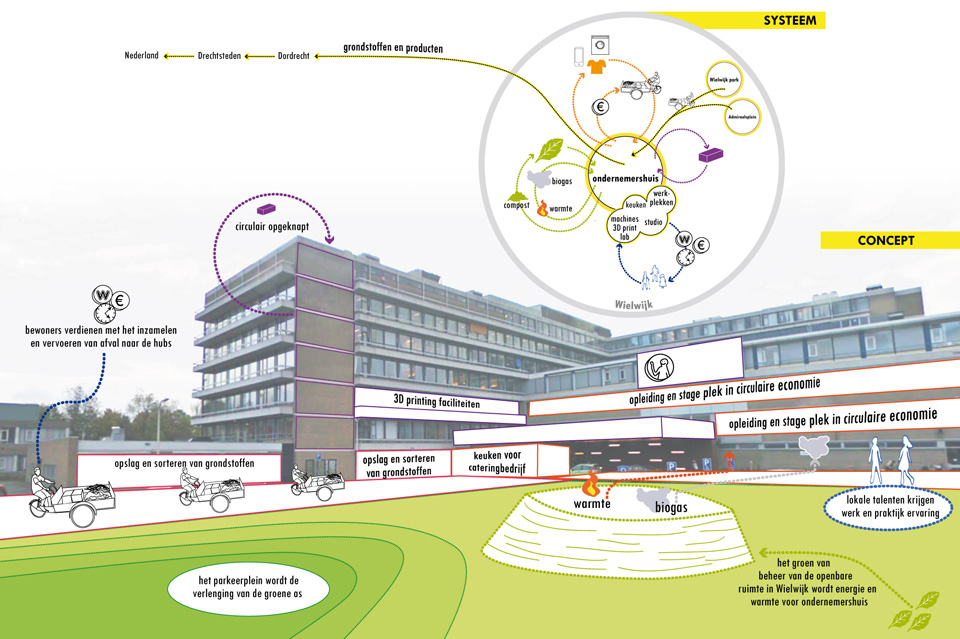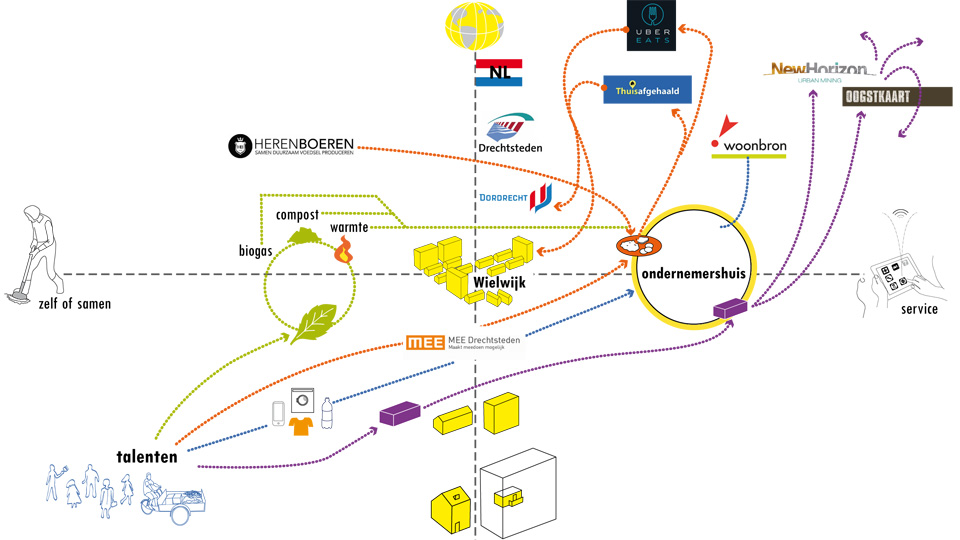Project Description
[:nl]In de circulaire economie zijn er ook circulaire wijken. Maar wat is een circulaire wijk? En wat betekent de circulaire economie voor de Dordtse wijk Wielwijk? Met deze vraag kwam het College van Rijksadviseurs naar ons, want als onderdeel van de City Deal Circulaire Stad wilden zij onderzoeken wat het rijksbeleid betekent voor een wijk en vice versa. Samen met het adviesbureau Over Morgen zijn wij op pad gegaan en via bezoeken, workshops en een ontwerpend onderzoek tot een antwoord gekomen.
De urgentie in Wielwijk is niet de circulaire economie; bewoners voelen niet de urgentie dat grondstoffen opraken. Dus begin niet over grondstoffen en grondstofstromen, want dat is voor veel wijkbewoners niet iets om op in te haken. Het grootste probleem in Wielwijk, en eigenlijk veel naoorlogse wijken, is vooral de sociaaleconomische positie van de wijkbewoners. Deze positie was voor ons de aanleiding om te onderzoeken hoe de circulaire economie sociaaleconomisch waarde kan creëren in de wijk.
Aanpak: Via workshops zijn de talenten van de wijkbewoners onderzocht. Vervolgens zijn activiteiten samengesteld door talenten te combineren. Deze activiteiten zijn gekoppeld aan circulaire principes en grondstoffen in de wijk. Als laatste is gezocht waar de circulaire activiteiten de wijkvernieuwing versterken.
Circulaire wijk
Voor de circulaire wijk hebben we een concept ontwikkeld waarin talenten, grondstoffen en initiatieven gebundeld worden en samenkomen op bepaalde plekken. Deze bundeling noemen wij feeders en de plekken waar zij samenkomen hubs. In deze hubs vinden de circulaire activiteiten plaats. De hubs spelen in op de wijkvernieuwing en versterken bestaande kwaliteiten van bepaalde plekken. Bijvoorbeeld; het wijkpark krijgt een strand en kantine, waardoor de kwaliteit van het park en wijk toeneemt, grondstoffen verzameld kunnen worden en gebruikt worden voor duurzame energie. Daarnaast krijgen wijkbewoners werkervaring en dragen zij bij aan de wijk. Op deze manier zijn een drietal hubs ontwikkeld rondom ondernemerschap en ontmoeten. De hubs liggen allemaal in de nieuwe groene as en versterken daardoor het gebruik van deze as en verbinden de hubs met de omliggende wijken en bedrijventerreinen. In dit systeem is Wielwijk ook een feeder voor de circulaire activiteiten op andere plekken in Dordrecht en de Drechtsteden.

Organisatie
Een groot aandachtspunt was de vraag hoe het systeem van feeders en hubs zou werken. Hierbij speelde de vraag op welk schaalniveau een circulair systeem werkt en wie verantwoordelijk is. We hebben vier scenario’s ontwikkeld waarbij het schaalniveau ging van huis- en tuintoepassingen tot een wereldwijd systeem en de verantwoordelijkheid varieerde van liggend bij (collectieven van) particulieren tot aan overheden en multinationals. We hebben aan de hand van de drie hubs laten zien dat alle partijen en alle schaalniveaus verbonden kunnen worden en dat de ambitie van de gemeente hierbij sturend kan zijn.

Het rapport is te downloaden via de site van het College van Rijksadviseurs (klik hier).
Het was een ontwerpend onderzoek bedoeld om beleid te maken. Voor het onderzoek zijn wij daarom niet in gesprek gegaan met bewoners omdat dit te prematuur was. We zouden verkeerde verwachtingen kunnen scheppen over de mogelijkheden.
In onze projecten speelt de circulaire economie steeds meer een belangrijke rol. Naast de circulaire wijk hebben wij ook plannen gemaakt voor de circulaire haven van Amsterdam en hoe een winkelcentrum kan bijdragen aan de circulaire economie door een andere positie in te nemen in de economische keten.[:en]What is the definition of a circular neighbourhood? And what is the meaning of the concept of circular economy for the Wielwijk neighbourhood in Dordrecht? These were the questions that the Board of Government Advisors asked URBANOS. In the frame of the ‘city deal’ about the circular city, they were interested in researching what the national policy of circular economy would mean for the municipal governments and vice versa. Together with advisory company Overmorgen, we deepen into these questions through site visits, interviews and research by design.
The first thing we concluded is that the residents of the neighbourhood Wielwijk did not feel an urgency for the circular economy. In this neighbourhood, as many post-war neighbourhoods, the biggest challenge lies in the socio-economic position of its residents. Therefore, there is no point to start discussing about the streams of materials or other technocratic approaches. This discussion is for most of the residents too far from their daily life and their daily concerns. Based on these initial findings, we decided to focus on researching the role of the circular economy to create socio-economic value in the neighbourhood.
Approach: Through workshops with different stakeholders from the neighbourhood, we identified the talents of residents. These were combined into possible activities to undergo in the neighbourhood and the activities were coupled to circular principles and streams of materials through the neighbourhood. Finally, we researched the circular activities that can reinforce the urban renewal that Wielwijk is undergoing.
A circular neighbourhood
To achieve a circular neighbourhood, we developed a concept involving talents, materials and existing initiatives bundled together in specific locations. All these elements that come together, are the feeders, and the place where they bundle are the hubs. All the circular activities take place in the hubs while the hubs have an important role in the further renovation of the neighbourhood and strengthening the qualities of some locations. For example, the Wielwijk park, planned for renovation, gets a quality boost with a beach (realized through locally cleaning the water) and a cafeteria where residents who are outside the working market can gain experience. This is also the place where used materials can be collected for reuse and recycling and where renewal energy can be generated and locally spent. In a similar way, other three hubs are designed to strengthen the entrepreneurship of the residents and stimulate new encounters and interaction. These hubs are located along the green axis the municipality has planned for the neighbourhood. In this way, the axis is reinforced with activities and it connects the new hubs with existing initiatives and the surrounding neighbourhoods. A system is created in which Wielwijk becomes also a hub for circular activities elsewhere in Dordrecht and the Drechtsteden.

Organization
A major point of attention was how the system of feeders and hubs would work. The question involved the scale at which a circular system works the best and the stakeholders that would be responsible. We developed four scenarios in which the scale varied from the single home until the global scale. The responsibility varied from doing everything yourself (alone or in a collective) until private companies, governments and multinationals. We showed on the basis of the three hubs that all parties and all scale levels can be connected and that the ambition of the municipality can be guiding.

The report (written in Dutch) can be downloaded from the site of the College van Rijksadviseurs (click here).
This research by design had as goal to inform policy making. Therefore we did not involved the local residents in the project because we considered to be at a too early stage. We wanted to avoid generating wrong expectations about the possibilities.
The circular economy is becoming increasingly more important in our projects. As a follow up of the circular Nieghbourhood the concept and idea was tested in the city of Zaandam. We did a workshop with the visitors of a neighbourhood centre and discussed the impact of different kinds of food, the materials flowing through their house and how they use their skills in making their won neighbourhood more circular. Besides the circular neighbourhoods, we also did research by design about the circular port of Amsterdam en about the way shopping malls could contribute to the circular economy in their neighbourhoods by taking a different role in the economical chain.
The project has been published in the urban design magazine Blauwe Kamer (March 2018).[:es]Que es un vecindario circular? Y mas específicamente que significa la economía circular para el barrio Wielwijk en la ciudad holandesa de Dordrecht? Estas fueron las preguntas que nos hizo la oficina asesora para la arquitectura y planeamiento espacial del gobierno holandés. En el marco del ‘city deal’ sobre economía circular, estaban interesados en lo que significa para los gobiernos locales, la política nacional de economía circular y viceversa. En colaboración con la oficina de consultoría en temas circulares Over Morgen (pasado mañana), profundizamos en estas preguntas usando investigación a través del diseño.
En un barrio del tipo de Wielwijk, los residentes no tienen prioridad en temas de la economía circular, los residentes no sienten la urgencia sobre la escasez de materias primas en un futuro. Las preocupaciones mas urgentes, en Wielwijk y en muchos barrios de la postguerra en los Países Bajos, son la posición socio-económica de los residentes.
Metodología: A través de talleres con diversos actores en el barrio, se identificaron talentos de los residentes. Estos talentos se combinaron para generar actividades que se pueden iniciar en el barrio. Estas actividades se conectar a principos de la economía circular y a los flujos de materiales existentes en el barrio.
Un vecindario circular
Para diseñar un barrio circular, desarrollamos un concepto en el cual talentos locales, materiales e iniciativas existentes se concentran en lugares específicos. Los talentos y materiales son los alimentadores que se conjugan en los hubs, donde tienen lugar las actividades circulares. Los hubs también refuerzan las cualidades del barrio al tiempo que agregan el componente circular al trayecto de renovación por el cual el barrio atraviesa. Por ejemplo, en el parque Wielwijk, que está siendo rediseñado por el municipio, se crea una playa y una cafetería. La playa, resultado de la aproximación circular al agua y la limpieza en sitio con elementos naturales y un ciclo biológico, genera extra calidad espacial en el vecindario y lo hace atractivo para diversos grupos de residentes del barrio y de áreas anexas. En la cafetería que se establece en el parque se pueden recolectar materiales para ser reusados en el otro hub y se genera empleo para residentes distantes de mercad laboral. De esta forma diseñamos 3 hubs para estimular los talentos locales alrededor del emprendimiento y encuentro entre locales. Los Hubs se localizan a lo largo del eje verde que el municipio ha diseñado para el barrio y de esta manera refuerzan el eje con mas actividades. De igual manera, este eje se convierte en un hub a una escala mas grande donde Wielwijk interactúa con otros centros de la región alrededor de actividades circulares.

Organización
Un punto de atención importante estaba en la pregunta sobre como funcionaria el desarrollo de este sistema de alimentadores y hubs. Dentro de esta pregunta rea importante la escala en la cual funcionan las actividades circulares y los actores que son responsables o están envueltos en el desarrollo de estas actividades. Para responder esta pregunta pensamos en escenarios que van desde resolver todo solo (autárquico) hasta contratar todo a empresas o multinacionales como un servicio (por ejemplo, movilidad como servicio) y desde la escala de la vivienda (resolver todo solo en su propia vivienda), pasando por la escala barrial, de la región, hasta llegar a la escala global. Los tres hubs fueron estudiados dentro de estos escenarios para llegar a concluir que cualquier combinación de actores a distintas escalas pueden realizar los hubs y que los mas importante para decidir quien, como y a que escala realiza la actividad circular son las ambiciones del municipio.

El reporte puede descargarse en la página web de los aseores del gobierno nacional (presione aqui).
Este proyecto fue una investigación a través del diseño enfocada a gernera política pública. Por esta razón, no se involucró a los residentes en el proyecto para evitar generar falsas expectativas sobre el alcance de la investigación.
La economía circular adquiere cada vez un rol mas importante dentro de nuestros proyectos. Además de vecindario circular, investigamos y diseñamos el puerto circular de Amsterdam y la forma como un centro comercial puede aportar a la economía circular si adquiere una posición distinta dentro de la cadena económica en el barrio.[:]


![[:nl]Buurtaanpak Rivierenwijk en Transwijk[:]](https://www.urbanos.nl/wp-content/uploads/buurtaanpak-utrecht-vergroenen-500x383.jpg)
![[:nl]Plein om te ontmoeten voor de Zeeheldenbuurt[:]](https://www.urbanos.nl/wp-content/uploads/plattegrond-leiden-500x383.jpg)
![[:nl]Anders Werken[:]](https://www.urbanos.nl/wp-content/uploads/anderswerken-500x383.jpg)
![[:nl]Inclusieve Stad[:en]Inclusive City[:]](https://www.urbanos.nl/wp-content/uploads/URBANOS-inclusieve-stad-1-500x383.jpg)
![[:nl]Urban mining in de regio[:]](https://www.urbanos.nl/wp-content/uploads/URBANOS-spaanse-polder-3Dvoor-web-500x383.jpg)